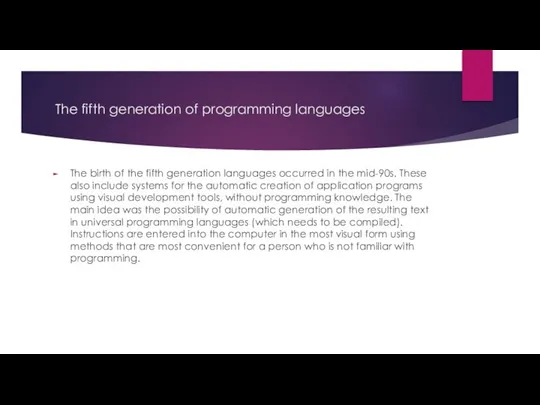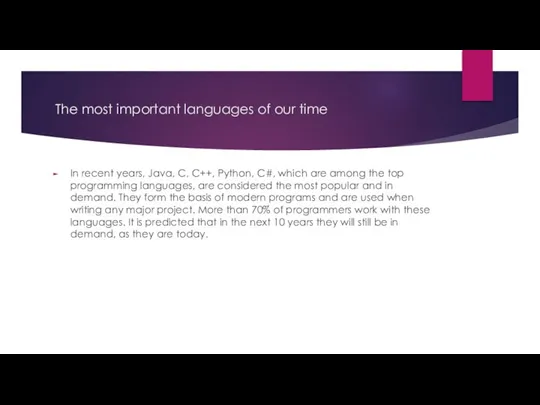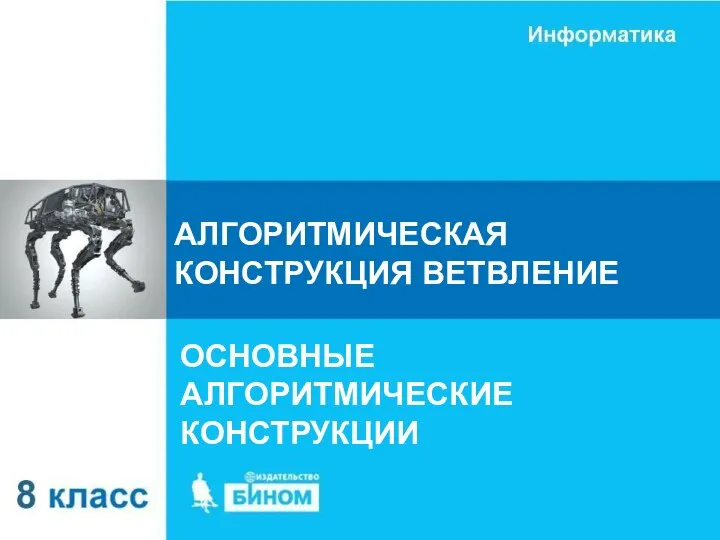- Главная
- Информатика
- Programming languages

Содержание
- 2. The Fourth Generation of programming languages The term fourth-generation programming languages (4GL) is better represented as
- 3. The fifth generation of programming languages The birth of the fifth generation languages occurred in the
- 4. The most important languages of our time In recent years, Java, C, C++, Python, C#, which
- 6. Скачать презентацию
Слайд 2The Fourth Generation of programming languages
The term fourth-generation programming languages (4GL) is
The Fourth Generation of programming languages
The term fourth-generation programming languages (4GL) is

better represented as fourth-generation development environments. They belong to the time period from the 1970s to the early 1990s.
Languages of this generation are designed for the implementation of large projects, increase their reliability and speed of creation, are focused on specialized applications, and use not universal, but object-oriented languages operating with specific concepts of a narrow subject area. Powerful operators are embedded in these languages, allowing one line to describe such functionality, which would require thousands of lines of source code to implement in the languages of younger generations.
Languages of this generation are designed for the implementation of large projects, increase their reliability and speed of creation, are focused on specialized applications, and use not universal, but object-oriented languages operating with specific concepts of a narrow subject area. Powerful operators are embedded in these languages, allowing one line to describe such functionality, which would require thousands of lines of source code to implement in the languages of younger generations.
Слайд 3The fifth generation of programming languages
The birth of the fifth generation languages
The fifth generation of programming languages
The birth of the fifth generation languages

occurred in the mid-90s. These also include systems for the automatic creation of application programs using visual development tools, without programming knowledge. The main idea was the possibility of automatic generation of the resulting text in universal programming languages (which needs to be compiled). Instructions are entered into the computer in the most visual form using methods that are most convenient for a person who is not familiar with programming.
Слайд 4The most important languages of our time
In recent years, Java, C, C++,
The most important languages of our time
In recent years, Java, C, C++,

Python, C#, which are among the top programming languages, are considered the most popular and in demand. They form the basis of modern programs and are used when writing any major project. More than 70% of programmers work with these languages. It is predicted that in the next 10 years they will still be in demand, as they are today.
- Предыдущая
Алкалоиды. Группы тропанаСледующая -
Карта желаний Алгоритмическая конструкция ветвление. Основные алгоритмические конструкции
Алгоритмическая конструкция ветвление. Основные алгоритмические конструкции Политика информационной безопасности издательства
Политика информационной безопасности издательства Users. CREATE TABLE user
Users. CREATE TABLE user Контекстно-свободные языки и грамматики. Лекция 4
Контекстно-свободные языки и грамматики. Лекция 4 Мультимедиа
Мультимедиа Сложные условия
Сложные условия Компьютерные вирусы
Компьютерные вирусы Каблуки - красота или здоровье?
Каблуки - красота или здоровье? Основы алгоритмизации и программирования, лекция 16. Двумерные массивы. Часть 2
Основы алгоритмизации и программирования, лекция 16. Двумерные массивы. Часть 2 Портал Дошкола Тилли
Портал Дошкола Тилли Передача информации по техническим каналам к § 8 в учебнике И. Г. Семакина, Е. К. Хеннера
Передача информации по техническим каналам к § 8 в учебнике И. Г. Семакина, Е. К. Хеннера Компьютетрные объекты
Компьютетрные объекты Presentation name
Presentation name CSS. Стилевые свойства графики. Урок 14
CSS. Стилевые свойства графики. Урок 14 Аналитические публицистические жанры
Аналитические публицистические жанры Трубичинское сельское поселение
Трубичинское сельское поселение Выбор операционных систем
Выбор операционных систем ВКР: Использование интернет-технологий в муниципальном образовании для повышения эффективности системы управления
ВКР: Использование интернет-технологий в муниципальном образовании для повышения эффективности системы управления Информационные технологии в обработке текстов. Автоматическое чтение текста
Информационные технологии в обработке текстов. Автоматическое чтение текста Базы данных. Access 2007. Запросы
Базы данных. Access 2007. Запросы Лекция 3-4
Лекция 3-4 Cikl_for для курса (1)
Cikl_for для курса (1) Средства автоматизации проектирования автоматизированных систем
Средства автоматизации проектирования автоматизированных систем Сервис Справочная информация по объектам недвижимости в режиме online
Сервис Справочная информация по объектам недвижимости в режиме online Анализ экспериментальных данных: компьютерный лабораторный практикум
Анализ экспериментальных данных: компьютерный лабораторный практикум Medarm. Единая база данных
Medarm. Единая база данных 7 ways intelligent itsm can help you - storyboard
7 ways intelligent itsm can help you - storyboard Подготовка материалов на конкурс в облачной среде МойОфис
Подготовка материалов на конкурс в облачной среде МойОфис